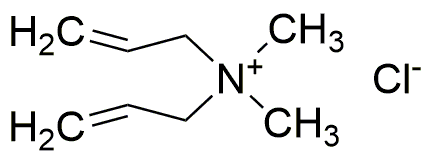Diallyldimethylammonium chloride is widely utilized in research focused on:
- Water Treatment: This compound is effective as a coagulant and flocculant in water purification processes, helping to remove contaminants and improve water quality.
- Antimicrobial Applications: It is used in various formulations as a biocide, providing protection against bacteria and fungi in industrial settings, such as in cooling towers and paper manufacturing.
- Polymer Production: Diallyldimethylammonium chloride serves as a monomer in the synthesis of cationic polymers, which are valuable in personal care products and hair conditioners for their conditioning properties.
- Textile Industry: This chemical is applied in textile finishing processes to enhance the durability and performance of fabrics, making them more resistant to stains and water.
- Adhesives and Sealants: It is incorporated into adhesive formulations to improve bonding strength and durability, particularly in construction and automotive applications.
General Information
Properties
Safety and Regulations
Applications
Diallyldimethylammonium chloride is widely utilized in research focused on:
- Water Treatment: This compound is effective as a coagulant and flocculant in water purification processes, helping to remove contaminants and improve water quality.
- Antimicrobial Applications: It is used in various formulations as a biocide, providing protection against bacteria and fungi in industrial settings, such as in cooling towers and paper manufacturing.
- Polymer Production: Diallyldimethylammonium chloride serves as a monomer in the synthesis of cationic polymers, which are valuable in personal care products and hair conditioners for their conditioning properties.
- Textile Industry: This chemical is applied in textile finishing processes to enhance the durability and performance of fabrics, making them more resistant to stains and water.
- Adhesives and Sealants: It is incorporated into adhesive formulations to improve bonding strength and durability, particularly in construction and automotive applications.
Documents
Safety Data Sheets (SDS)
The SDS provides comprehensive safety information on handling, storage, and disposal of the product.
Product Specification (PS)
The PS provides a comprehensive breakdown of the product’s properties, including chemical composition, physical state, purity, and storage requirements. It also details acceptable quality ranges and the product's intended applications.
Certificates of Analysis (COA)
Search for Certificates of Analysis (COA) by entering the products Lot Number. Lot and Batch Numbers can be found on a product’s label following the words ‘Lot’ or ‘Batch’.
*Catalog Number
*Lot Number
Certificates Of Origin (COO)
This COO confirms the country where the product was manufactured, and also details the materials and components used in it and whether it is derived from natural, synthetic, or other specific sources. This certificate may be required for customs, trade, and regulatory compliance.
*Catalog Number
*Lot Number
Safety Data Sheets (SDS)
The SDS provides comprehensive safety information on handling, storage, and disposal of the product.
DownloadProduct Specification (PS)
The PS provides a comprehensive breakdown of the product’s properties, including chemical composition, physical state, purity, and storage requirements. It also details acceptable quality ranges and the product's intended applications.
DownloadCertificates of Analysis (COA)
Search for Certificates of Analysis (COA) by entering the products Lot Number. Lot and Batch Numbers can be found on a product’s label following the words ‘Lot’ or ‘Batch’.
*Catalog Number
*Lot Number
Certificates Of Origin (COO)
This COO confirms the country where the product was manufactured, and also details the materials and components used in it and whether it is derived from natural, synthetic, or other specific sources. This certificate may be required for customs, trade, and regulatory compliance.

